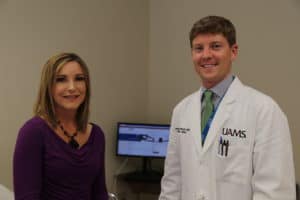September 19, 2018
Faulkner County Woman Feels Boundless Following Joint Replacement
Sept. 18, 2018 | In most cases, broken bones heal once given proper surgical treatment. New bone forms to reconnect broken pieces.
However, Linda Simon of Conway found herself still in pain long after a surgery to repair her broken hip in 2017. Her bone never completely healed. This happens in less than 10 percent of cases and is called a fracture “nonunion.”
“It got to a point where I just didn’t trust the leg. It was painful, and I was afraid to put weight on it. It just didn’t feel right.”
Simon’s local physician referred her to orthopaedic surgeon Jeff Stambough, M.D., an assistant professor in the Department of Orthopaedics in the UAMS College of Medicine.
Stambough studied her images and took Simon through a series of tests to help determine why the bone had not healed. Factors that increase the risk of a fracture nonunion include older age, endocrine disorders, infection, and tobacco use. Stambough concluded that Simon’s initial break developed gradually and was well-established before completely fracturing.
Stambough told Simon there were a few options to address the fracture nonunion. The first involved a revision fracture repair surgery that would preserve her natural bone in her hip joint. Stambough set up a consultation with a trauma surgeon who specializes in that treatment.
“A unique thing about UAMS is that we have all different sub-specialists on one campus,” Stambough said. “In this case, it allowed Ms. Simon to meet with an expert and make an informed decision that works best for her.”
The benefits of a nonunion surgery, Stambough says, is that Simon could keep her natural hip joint and bone. But there was a significant risk that it may not heal again and could shorten the leg.
“It can also make future replacement surgery more difficult because there is more hardware and an alteration in the hip alignment,” Stambough said.
“It was scary to me at first,” Simon said.
A second option was hip replacement surgery. One benefit of a hip replacement is having one surgery that would be successful and last many years. It could also re-establish equal leg lengths. The risks include the possibility of further fracture or dislocation because the surgeon is placing in an artificial hip.
“I went with a hip replacement because I didn’t want to risk the bone not healing again,” Simon says. “My pain had been excruciating at times and I didn’t want to have that possibility again.”
Because Simon already had previous hip surgery, the surgical approach was different. Stambough would have to do a conversion surgery. Primary hip replacement, Stambough says, is more straightforward regarding planned bone cuts and anatomical relationships. In conversion surgery, there is often hardware in place from a prior procedure that requires removal. That can raise the risk of a fracture.
“When there is prior hardware in the femur, it can be more difficult to get hip replacement components to fit appropriately,” Stambough said. “So different, more complex replacement options are often needed.”
Simon’s surgery and recovery went well, and she feels like she made the best-informed decision.
“I haven’t found anything I can’t do,” she said. “I don’t feel like I even had surgery.”


